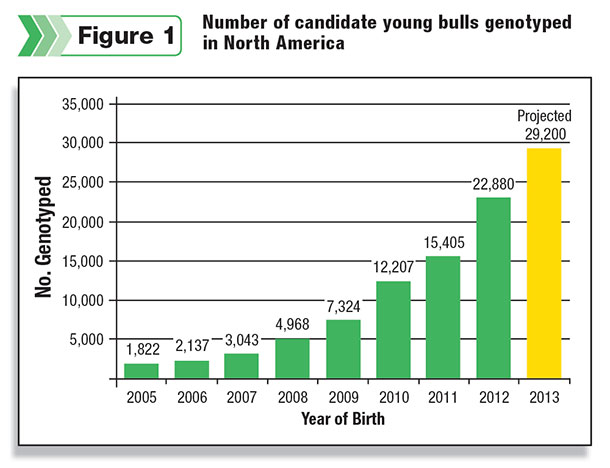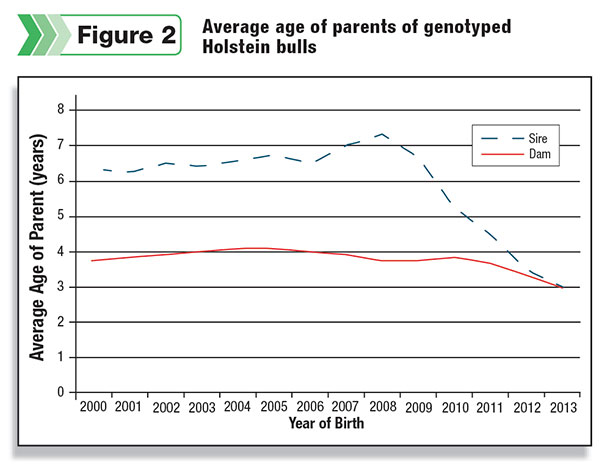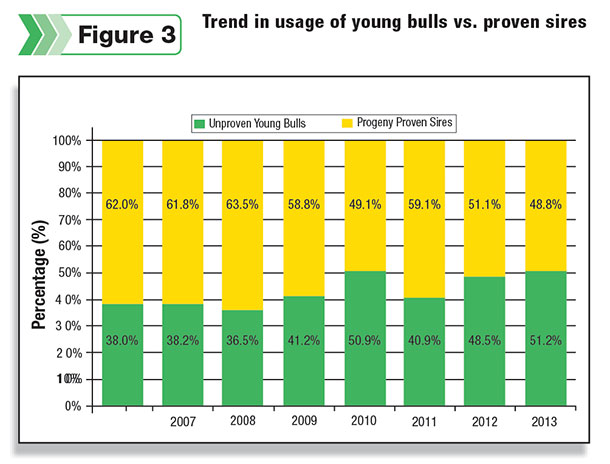To take a closer look at the impact of genomics on genetic selection in Canada, one approach is to assess changes on each component affecting genetic progress in dairy cattle selection.
Rate of genetic gain
There are four key factors that affect the rate of genetic progress achieved by various selection strategies. These include the following.
- The intensity of selection, which is measured by the proportion of the population that is used as parents of the next generation
- The accuracy of selection, which is usually measured by the average reliability of genetic evaluations used to make decisions about parents of the next generation of animals
- The degree of genetic variability that exists in the population for each trait of interest, which would not be significantly affected in only five years
- The generation interval, which is measured by the average age of the parents when the next generation is born.
When assessing each of these components of genetic progress realized in a breed, there are four pathways of selection to be considered, of which the selection of sires and dams of future A.I. young sires are the two most influential.
At the herd level, it is the producer’s selection of sires to be used that has traditionally been responsible for about 90 percent of the genetic progress achieved.
Genomics does, however, offer producers more opportunity to select the parents of future replacement heifers, especially in conjunction with the use of reproductive technologies such as sexed semen and embryo transfer.
Intensity of selection
A critical and major shift that has taken place due to the arrival of genomics is the ability for A.I. organizations to genotype potential young bull candidates prior to any decision to purchase for semen collection.

As shown in Figure 1, this new pre-selection step became available for young bull candidates born in 2008, at which time roughly 5,000 young bulls were genotyped as a tool to identify a group of approximately 2,000 that were eventually purchased for A.I. in North America.
Nowadays, for bulls born in 2013, more than 29,000 are expected to be genotyped, and roughly 2,000 are expected to be purchased by an A.I. organization: a ratio of nearly one-in-15.
Accuracy of selection
In terms of improvement in the accuracy of selection decisions, there are two areas where genomics has had a significant impact. First, the average reliability of genetic evaluations available for genotyped young bulls and heifers has almost doubled compared to using parent average alone.
For genomic young bulls that are sons of a genomic young sire, rather than a progeny proven sire, the gain in reliability over parent average is slightly reduced to 30 percent, instead of 33 percent, to reach an average reliability of 66 percent for LPI in Holsteins.
Second, for progeny-proven sires, genomics has significantly improved the accuracy of evaluations for traits with low heritability, namely herd life, daughter calving ability and daughter fertility.
Generation interval
Not only has genomics allowed for the pre-screening of potential young bulls for entry into A.I., as shown in Figure 1, but the increased accuracy of evaluations for genotyped young bulls, heifers and cows has turned the focus of selection decisions to younger animals.

Figure 2 shows the trend in the average age of parents of genotyped Holstein bulls by year of birth. For bulls born prior to 2009, which was before genomic evaluations were official in North America, the average age of sires being considered for entry into A.I. was over 6 years, while their dams averaged about 4 years old.
For genotyped young bull candidates born in 2013, the average age of their sire reached 3 years (i.e., 55 percent reduction) and the age of their dams reduced by 25 percent to also equal 3 years.
Proven versus young sires
A key outcome of genomics has been an expected attraction by producers towards genomic young sires with a corresponding reduction in usage of proven sire semen.
Part of this attraction stems from the superior level of genetic potential being offered to producers interested in using genomic young sires. In fact, prior to genomics, the average LPI of young sires entering A.I. was increasing, on average, by 92 points per year, which has now increased to 160 LPI points per year for bulls born since 2009.
Prior to genomics, young sire semen occupied less than 40 percent of the market share with progeny-proven sires representing the main A.I. product of interest to producers.

After an initial spike in usage of genomic young sires in 2010, there has been a continuous increase in interest towards this category of A.I. sire, which surpassed 51 percent of the market share in 2013 (Figure 3).
In fact, for every month since May 2013, more than 50 percent of Holstein inseminations in Canada have been done using semen from genomic young sires.
Summary
Achieving genetic progress in any breed of dairy cattle requires balancing selection intensity and accuracy with generation interval without having a negative impact of genetic variability.
For decades past, this was done by efficient young sire proving programs aimed at identifying elite sires once they were progeny-proven at 5 years old and subsequently using them as sires of the next generation of replacement heifers and young bulls entering A.I.
With the arrival of genomic evaluations in 2009, this traditional, well-proven strategy has changed. Thanks to genomics, tens of thousands of candidate young bulls are now being genotyped each year, of which one in 15 are currently being selected for entry into A.I. based on genetic evaluations that have reliability levels almost doubled compared to parent average alone.
This pre-selection step using genomics has contributed to the superior genetic level of young sires offered to producers, which continues to increase every year at a faster rate than before.
The use of younger parents, including unproven genomic young bulls as well as genotyped heifers and young cows, to produce the next generation of A.I. young sires is also an important factor contributing to the increased rates of genetic progress achieved to date.
Simply stated, genomics has already had a major impact on genetic selection decisions taken by A.I. organizations and this, in turn, has translated into an increased attraction towards genomic young sires that now occupy more than 50 percent of the market share in Canada. PD
—Excerpts from the Canadian Dairy Network website, January 2014
Brian Van Doormaal
General Manager
Canadian Dairy Network






